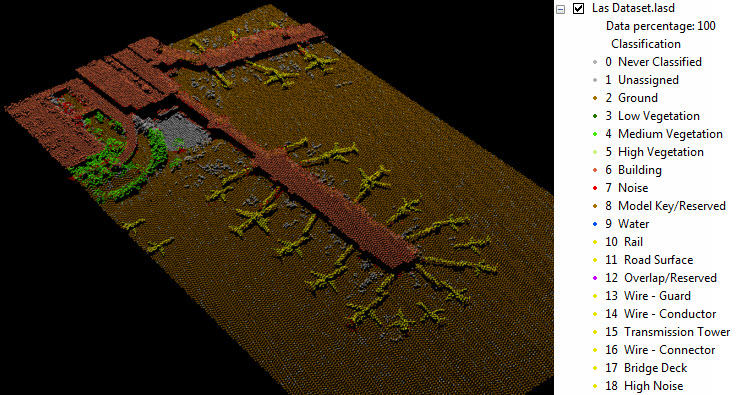Every lidar point can have a classification assigned to it that defines the type of object that has reflected the laser pulse. Lidar points can be classified into a number of categories including bare earth or ground, top of canopy, and water. The different classes are defined using numeric integer codes in the LAS files.
Classification codes were defined by the American Society for Photogrammetry and Remote Sensing (ASPRS) for LAS formats 1.1, 1.2, 1.3, and 1.4. ArcGIS supports all versions of LAS. LAS version 1.4 is the latest LAS version and adds additional point classification and information which is outlined below.

Only LAS 1.1 and later has a predefined classification system in place. Unfortunately, the LAS 1.0 specification does not have a predefined classification scheme, nor do the files summarize what, if any, class codes are used by the points. You need to obtain this information from the data provider.
Class flags: LAS format 1.1 to 1.4
When a classification is carried out on lidar data, points may fall into more than one category of the classification. Classification flags are used to provide a secondary description or classification for lidar points. With LAS version 1.0, a lidar point could not simultaneously maintain two assigned classification attributes. For example, a lidar return from water may need to be removed from the final output dataset, but it still should remain and be managed in the LAS file as a collected lidar point. Using LAS version 1.0, this point could not be set as water and be withheld from analysis.
In later versions (LAS 1.1 and later), class flags were used to solve this problem. Classification flags were added to the LAS standard to flag points with information additional to the traditional classification. Synthetic, key-point, withheld, and overlap flags can be set for each lidar point. These flags can be set along with the classification codes. For example, a water record could be given a classification code for water (9), as well as a withheld flag. The point will remain in the dataset but will be withheld from any additional analysis on the LAS files.
The following table describes the classification flags that can be set:
| Field name | Description |
|---|---|
Synthetic | A point that was created by other than lidar collection, such as digitized from a photogrammetric stereo model. |
Key-point | A point considered to be a model key-point and should not be withheld in any thinning algorithm. |
Withheld | The point should not be included in processing. |
Overlap | A point that is within the overlap region of two or more flight lines or swaths (LAS version 1.4 specific). |
Classification codes: LAS format 1.1 - 1.4
If you are working with LAS 1.1 - 1.4 specification, refer to the predefined classification schemes defined by the American Society for Photogrammetry and Remote Sensing (ASPRS) for the desired data category. The following table lists the LAS classification codes defined by ASPRS for these LAS versions:
| Classification value | Meaning |
|---|---|
0 | Never classified |
1 | Unassigned |
2 | Ground |
3 | Low Vegetation |
4 | Medium Vegetation |
5 | High Vegetation |
6 | Building |
7 | Low Point |
8 | Reserved * |
9 | Water |
10 | Rail |
11 | Road Surface |
12 | Reserved * |
13 | Wire - Guard (Shield) |
14 | Wire - Conductor (Phase) |
15 | Transmission Tower |
16 | Wire-Structure Connector (Insulator) |
17 | Bridge Deck |
18 | High Noise |
19-63 | Reserved |
64-255 | User Definable |
Modifying classification codes
You can use the LAS Dataset Profile View window for interactive editing or many geoprocessing tools listed below to classify LAS points referenced in a LAS dataset.
- Change LAS Class Codes
- Classify LAS Building
- Classify LAS Ground
- Classify LAS Noise
- Classify LAS Overlap
- Set LAS Class Codes Using Features
- Locate LAS Points By Proximity
- Classify LAS By Height
Flags can be set or cleared in any combination using ArcGIS.
For more information on working with classification codes in ArcGIS, see Working with LAS classifications.